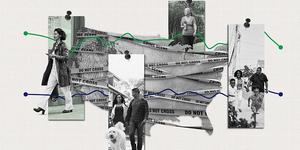GALLUP NEWS SERVICE
PRINCETON, NJ -- Democratic candidate John Kerry approaches his party's convention next week in the context of a presidential race that is both even and stable. At the same time, interest and enthusiasm in the presidential election this year is at record-high levels, particularly among Democrats.
Despite a wide range of events that might have reasonably been expected to affect the shape of the presidential race, the positioning of the two major party candidates over the last several months has actually changed very little. Since late March, the percentage of likely voters indicating they would vote for Kerry has ranged narrowly from 45% to 50%, and the percentage voting for George Bush has similarly ranged between 44% and 51%.
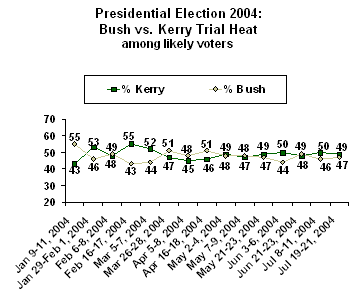
The final CNN/USA Today/Gallup poll before the Democratic convention, conducted Monday through Wednesday of this week, shows the race to be a virtual tie, with Kerry the choice of 49% of likely voters, and Bush the choice of 47%.
Among all registered voters, the race is similar, with Kerry taking a slightly larger 49% to 45% lead.

Historical precedent suggests Kerry is likely to come out of his convention with a positive "bounce" of perhaps as much as five to seven percentage points in the projected vote. If that is the case, Kerry could conceivably lead the Bush-Cheney ticket by double digits as August begins, particularly if the bounce is a result of Bush supporters switching to Kerry, as opposed to Kerry mainly picking up voters who are currently undecided.
The Bush campaign has promised that the president will actively campaign in the four weeks between the end of the Democratic convention and the beginning of the Republican convention in New York on Aug. 30, so it is possible that Kerry could lose some of his lead during the month of August. Then, if history repeats itself, Bush should benefit from his own "bounce" following the GOP convention, suggesting the possibility that the race will become -- once again -- a statistical tie as the last two months of the campaign get underway after Labor Day.
Remarkable Parity
A series of additional findings from the most recent poll underscore the remarkably even nature of this year's presidential race:
1. The public's rating of the job Bush is doing as president is split right down the middle, with 49% of Americans saying they approve and 47% saying they disapprove. Job approval ratings for an incumbent are a good indicator of their re-election probabilities, and the fact that Bush's job rating is almost at the 50% mark again shows just how close the race is likely to be.
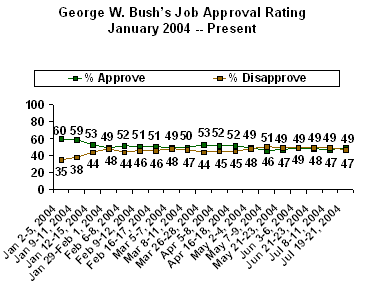
As was the case for the trial heat ballot, Bush's job approval rating has been remarkably constant in recent months, fluctuating only between 46% and 49% across seven separate Gallup Polls conducted since early May.
2. Likely voters are essentially split in their responses to a basic question asking if Bush deserves to be re-elected, mirroring the close nature of the trial heat ballot.
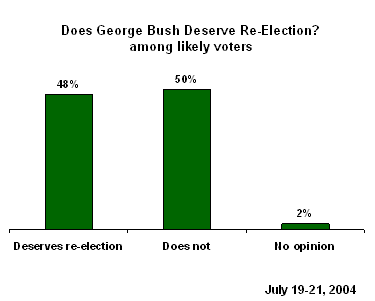
3. The percentage of Americans who have a favorable image of Bush, 52%, is essentially on par with the 55% who have a favorable opinion of Kerry. (Still, at the same time it is important to note that Bush has a higher unfavorable rating than Kerry does, so that the ratio of favorable to unfavorable opinions is somewhat more positive for Kerry than it is for Bush.)
Americans Paying Close Attention
Several indicators in the latest poll give rise to the conclusion that Americans are paying an unusually high level of attention to this year's presidential campaign.
- Sixty-six percent of Americans say they have given "quite a lot" of thought to this presidential election. This continues to be much higher than has been found in the summer before other elections in which Gallup has used this measure. In mid-July of 2000, for example, only 39% had thought quite a lot about the election.
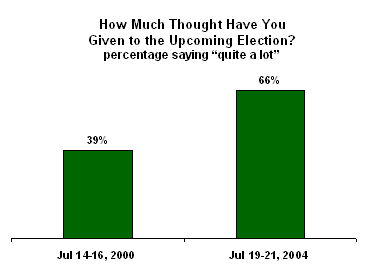
- Sixty percent of registered voters say they are more enthusiastic about voting this year compared with previous elections, while only 25% say they are less enthusiastic. This is considerably higher than was found even late in the election years of 2000 and 1996.
|
Compared to previous elections, are you more enthusiastic about voting than usual, or less enthusiastic? |
||||
|
|
More |
Less |
|
No |
|
|
% |
% |
% |
% |
|
Registered voters |
|
|
|
|
|
2004 Jul 19-21 ^ |
60 |
25 |
14 |
1 |
|
2004 Mar 26-28 |
52 |
29 |
18 |
1 |
|
2004 Jan 29-Feb 1 |
56 |
32 |
10 |
1 |
|
2000 Oct 13-15 |
38 |
39 |
20 |
3 |
|
2000 Mar 10-12 |
39 |
38 |
22 |
1 |
|
2000 Jan 7-10 |
45 |
37 |
17 |
1 |
|
1996 Oct 23-24 |
17 |
36 |
45 |
2 |
|
(vol.) Volunteered response |
|
|
|
|
- Sixty-one percent of registered voters are extremely or very enthusiastic about voting for president in this year's election, while only 17% say they are not too or not at all enthusiastic.
|
How enthusiastic would you say you are about voting for president in this year's election? |
||||||
|
|
|
|
Some-what |
Not |
Not |
No opinion |
|
|
% |
% |
% |
% |
% |
% |
|
Registered voters |
|
|
|
|
|
|
|
2004 Jul 19-21 |
28 |
33 |
21 |
13 |
4 |
1 |
|
2003 Oct 24-26 ^ |
19 |
34 |
31 |
11 |
4 |
1 |
|
|
|
|
|
|
|
|
|
National adults |
|
|
|
|
|
|
|
2004 Jul 19-21 |
25 |
31 |
22 |
13 |
8 |
1 |
|
2003 Oct 24-26 ^ |
18 |
32 |
32 |
12 |
5 |
1 |
Potential Danger Signs for Bush
There are a few worrisome signs for Bush in the data that suggest the Democrats may -- at this point -- have an emotional edge in the election.
Bush's opponents appear on several measures to be stronger about their feelings than are Bush's supporters. Although about as many Americans approve as disapprove of Bush's job performance, two recent polls show that those who disapprove are slightly more likely to say they feel strongly about their views than are those who approve.
|
Bush Job Approval |
|||||
|
|
Strongly approve |
Moderately approve |
Moderately disapprove |
Strongly disapprove |
No |
|
|
% |
% |
% |
% |
% |
|
2004 Jul 19-21 |
30 |
19 |
12 |
35 |
4 |
|
|
|
|
|
|
|
|
2004 May 21-23 |
28 |
19 |
12 |
37 |
4 |
|
2003 Sep 19-21 |
30 |
20 |
15 |
32 |
3 |
|
2001 Oct 5-6 |
60 |
27 |
5 |
5 |
3 |
An analysis of the patterns of enthusiasm for voting by candidate choice shows that Democrats are significantly more enthusiastic than is the case for Republicans. Sixty-eight percent of Democrats say they are enthusiastic about voting this year, compared with just 51% of Republicans.
|
Compared to previous elections, are you more enthusiastic about voting than usual, or less enthusiastic? |
|||||
|
|
More |
Less |
|
No |
|
|
|
% |
% |
% |
% |
|
|
Republicans/Republican leaners |
|||||
|
2004 Jul 19-21 ^† |
51 |
32 |
15 |
2 |
|
|
2004 Mar 26-28 |
52 |
27 |
20 |
1 |
|
|
2004 Jan 29-Feb 1 |
53 |
31 |
15 |
1 |
|
|
2000 Mar 10-12 |
45 |
32 |
22 |
1 |
|
|
2000 Jan 7-10 |
51 |
32 |
16 |
1 |
|
|
|
|
|
|
|
|
|
Democrats/Democratic leaners |
|||||
|
2004 Jul 19-21 ^† |
68 |
20 |
12 |
-- |
|
|
2004 Mar 26-28 |
51 |
35 |
13 |
1 |
|
|
2004 Jan 29-Feb 1 |
59 |
34 |
6 |
1 |
|
|
2000 Mar 10-12 |
33 |
47 |
19 |
1 |
|
|
2000 Jan 7-10 |
39 |
42 |
17 |
2 |
|
|
|
|
|
|
|
|
|
^ |
Asked of half sample. |
||||
|
† |
BASED ON –219—REPUBLICANS OR REPUBLICAN LEANERS;
±7 PCT. PTS. |
||||
|
|
NOTE: Trend for presidential elections. |
||||
|
|
(Vol.) Volunteered response |
||||
Finally, an analysis of attention patterns shows that 72% of Kerry voters say they are paying quite a lot of attention to this year's presidential race, as opposed to 63% of Bush voters.
Survey Methods
Results are based on telephone interviews with 1,005 national adults, aged 18 and older, conducted July 19-21, 2004. For results based on the total sample of national adults, one can say with 95% confidence that the margin of sampling error is ±3 percentage points.
Results based on likely voters are based on the subsample of 709 survey respondents deemed most likely to vote in the November 2004 general election, according to a series of questions measuring current voting intentions and past voting behavior. For results based on the total sample of likely voters, one can say with 95% confidence that the margin of sampling error is ±4 percentage points. The likely voter model assumes a turnout of 50% of national adults, consistent with recent presidential elections. The likely voter sample is weighted down to match this assumption.
For results based on the sample of 878 registered voters, the maximum margin of sampling error is ±4 percentage points. In addition to sampling error, question wording and practical difficulties in conducting surveys can introduce error or bias into the findings of public opinion polls.
